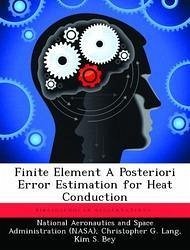This research investigates residual-based a posteriori error estimates for finite element approximations of heat conduction in single-layer and multi-layered materials. The finite element approximation, based upon hierarchical modelling combined with p-version finite elements, is described with specific application to a two-dimensional, steady state, heat-conduction problem. Element error indicators are determined by solving an element equation for the error with the element residual as a source, and a global error estimate in the energy norm is computed by collecting the element contributions. Numerical results of the performance of the error estimate are presented by comparisons to the actual error. Two methods are discussed and compared for approximating the element boundary flux. The equilibrated flux method provides more accurate results for estimating the error than the average flux method. The error estimation is applied to multi-layered materials with a modification to the equilibrated flux method to approximate the discontinuous flux along a boundary at the material interfaces. A directional error indicator is developed which distinguishes between the hierarchical modeling error and the finite element error. Numerical results are presented for single-layered materials which show that the directional indicators accurately determine which contribution to the total error dominates.








